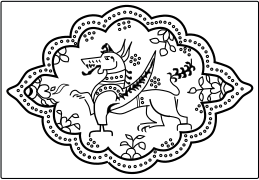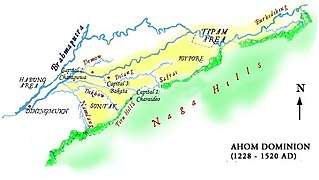Suhungmung
Suhungmung (r. 1497–1539) (Assamese: স্বৰ্গদেউ চুহুংমুং) was one of the most important Ahom kings belonging to the Dihingia clan, who ruled at the cusp of Assam's medieval history. His reign broke from the early Ahom rule and established a multi-ethnic polity in his kingdom. Under him the Ahom Kingdom expanded greatly for the first time since Sukaphaa, at the cost of the Chutiya and the Kachari kingdoms. He also successfully defended his kingdom against the first Muslim invasions under Turbak Khan. During his time, the Khen dynasty collapsed and the Koch dynasty ascended in the Kamata kingdom. His general, Tonkham, pursued the Muslims up to the Karatoya river, the western boundary of the erstwhile Kamarupa Kingdom, the farthest west an Ahom king had ventured in its entire six hundred years of rule.
| Chao Suhungmung | |||||
|---|---|---|---|---|---|
| Chao-Pha, | |||||
| Ahom King | |||||
| father | Supimphaa | ||||
| Son | Suklenmung | ||||
| Reign | (r. 1497–1539) | ||||
| |||||
| Religion | Ahom religion | ||||
| Ahom dynasty | ||||||||||||||||||||||||||||||||||||||||||||||||||||||||||||||||||||||||||||||||||||||||||||||||||||||||||||||||||||||||||||||||||||
|---|---|---|---|---|---|---|---|---|---|---|---|---|---|---|---|---|---|---|---|---|---|---|---|---|---|---|---|---|---|---|---|---|---|---|---|---|---|---|---|---|---|---|---|---|---|---|---|---|---|---|---|---|---|---|---|---|---|---|---|---|---|---|---|---|---|---|---|---|---|---|---|---|---|---|---|---|---|---|---|---|---|---|---|---|---|---|---|---|---|---|---|---|---|---|---|---|---|---|---|---|---|---|---|---|---|---|---|---|---|---|---|---|---|---|---|---|---|---|---|---|---|---|---|---|---|---|---|---|---|---|---|---|
 | ||||||||||||||||||||||||||||||||||||||||||||||||||||||||||||||||||||||||||||||||||||||||||||||||||||||||||||||||||||||||||||||||||||
|
||||||||||||||||||||||||||||||||||||||||||||||||||||||||||||||||||||||||||||||||||||||||||||||||||||||||||||||||||||||||||||||||||||
He was the first Ahom king to adopt a Hindu title, Swarganarayana, indicating a move towards an inclusive polity; and Ahom kings came to be known as the Swargadeo which is the Assamese translation of Ahom word Chao-Pha. He is also called the Dihingia Raja, because he made Bakata on the Dihing River his capital and also belonged to the Dihingia clan. Suhungmung was the last progenitor Ahom king (all subsequent kings were his descendants).
Expansion
Under Suhungmung the Ahom Kingdom acquired a vision of an extended polity and consolidated rule. He began by suppressing the revolt of the Aitonia Nagas in 1504 and making them accept Ahom overlordship.[1] He surveyed the country and annexed the Habung region.[1](which was a part of Chutia kingdom).[2] But his biggest successes was against the rest of the Chutiya Kingdom.

Against Chutiya Kingdom
After Suhungmung annexed Habung and Panbari, which were previously Chutiya principalities in 1512[3][4], the then Chutiya king Dhirnarayan decided to attack the Ahom kingdom to prevent any further expansion. He invaded the Ahom kingdom in 1513 at Dikhoumukh. But, the Ahoms resisted the invasion. The Chutiyas again attacked the Ahoms in 1520 and occupied the areas up to Namdang and Mungkhrang. But, soon Dhirnarayan died and the reign of the kingdom was passed to the son-in-law named Nitipal who was weak and inefficient in ruling. Many other vassal chiefs of Lakhimpur, Majuli, Biswanath became independent and were eventually annexed by the Ahoms. In 1522, the Ahoms fought back, re-occupied their lost territories and erected a fort at Dibrumukh (Dibrugarh). Although, Nitipal tried to attack the fort the following year, he was unsuccessful. Suhungmung then extended the Ahom Kingdom to the mouth of the Tiphao River, where a new fort was constructed. The Chutiyas fortified Sadia but they were soon defeated. The Chutiyas were pursued further and their king and prince were killed in battle. Suhungmung established the office of the Sadiakhowa Gohain to look after the newly acquired Sadia region, while he appointed the Borgohain and Buragohain to rule the region between Biswanath and Dhemaji. He also created the Borpatrogohain post to rule between the territories of the other two gohains.[5] Though this was not the end of the conflict it brought to an end the first major expansion of the Ahom Kingdom.
Against Kachari Kingdom
In 1526, Suhungmung marched against the Kachari Kingdom. In 1531 Khunkhara, the Kachari king, sent forces under his brother Detcha to drive the Ahoms away from Marangi but the Kachari army was defeated and their commander killed. The Kacharis were pursued up to the capital Dimapur and Khunkhara had to flee. Suhungmung established a Kachari prince, Detsung, as the Kachari king. But Detsung rose in revolt in a few years, and the Ahoms pursued him till Jangmarang where he was killed. The Kachari Kingdom abandoned Dimapur permanently and established their new capital at Maibong. Unlike the Chutiya Kingdom, Suhungming did not take direct possession of the Kachari Kingdom.
Muslim invasions
The first Muslim invasion of the Ahom Kingdom occurred in 1527, but it was defeated and pushed back to the Burai River. A few years later, there was another attempt when a commander advanced up the Brahmaputra in fifty vessels. This too was defeated. In yet another expedition, the Barpatra Gohain slain the commander, Bit Malik, and captured cannons and guns. The most successful among these initial raids on the Ahom Kingdom was the one led by Turbak.
Turbak, a Gaur commander, advanced against the Ahom Kingdom in April 1532 with a large force. He first faced Suklen, Suhungmung's son, at Singri. In this battle Suklen was defeated and wounded and the Ahoms retreated to Sala. The Ahoms again faced reverses at Sala and some other expeditions thereafter, but won the first significant victory in March 1533 when a naval force was defeated with heavy losses to Turbak's forces. This led to a period of stalemate with the two armies encamped on opposite banks of the Dikrai River.
The Ahoms finally attacked the invaders and defeated them in a number of battles. In the final battle fought near the Bharali River, Turbak was killed and his army pursued till the Karatoya river in present-day North Bengal. The captured soldiers subsequently became the first significant Muslim population of the Ahom Kingdom. They were called Garia since they were from Gaur, and the appellation was later extended to all Muslims. This population finally became well known as expert brass craftsmen.
The Buranjis mention the first use of firearms by the Ahoms in these battles.
Death
Suhungmung was assassinated by a servant, Ratiman, who stabbed him as he slept in his palace. It is suspected that Suhungmung's son Suklenmung, who became the next king, was responsible for the death.
Descendants
Suhungmung had four sons. The eldest, Suklen, who succeeded him, was established as the Tipam Raja. His second son, Suleng (also spelled Sureng and sometimes called Deoraja), was established as the Charing Raja. Though Suleng himself did not become a king, some of his descendants enjoyed kingship for some time. The third son, Suteng, was established as the Namrupiya Raja, and his descendants established the Tungkhungia line. The fourth son, Sukhring, also called Dop Raja, remained without any estate.[6]
- Suhungmong
- Suklenmung (Tipam Raja)
- Sukhaamphaa (Khora Raja)
- Susenghphaa (Pratap Singha)
- Suramphaa (Bhoga Raja)
- Sutingphaa (Noriya Raja)
- Sutamla (Jayadhwaj Singha)
- Susenghphaa (Pratap Singha)
- Sukhaamphaa (Khora Raja)
- Suleng (Deoraja) (Charing)
- ??
- Supangmung, Chakradwaj Singha
- Sunyatphaa, Udayaditya Singha
- Suklamphaa, Ramdhwaj Singha
- ??
- Suteng (Namrup)
- Saranga Gohain
- Gobar Roja
- Gadadhar Singha
- Gobar Roja
- ??
- Sudoiphaa (Arjun Konwar)
- Saranga Gohain
- Sukhring (none)
- Suklenmung (Tipam Raja)
New offices
Suhungmung established new Ahom positions.
- Borpatrogohain is the third of the great Gohains (the others being Burhagohain and Borgohain, instituted by Sukaphaa). The first Barpatra Gohain was an Ahom prince brought up by a Naga chief.
- Sadiakhowa Gohain looked after the Sadia region taken from the Sutiyas in 1523.
- Marangikhowa Gohain looked after the lower Dhansiri river valley taken from the Kacharis.
See also
- Ahom dynasty
- Ahom kingdom
- Assam
- Singarigharutha ceremony
Notes
- Gait, Edward Albert (1906). A history of Assam. Thacker, Spink & co. pp. 83–84. ISBN 1-145-65935-7.
- Guha, Amalendu, The Ahom Political System: An Enquiry into the State Formation Process in Medieval Assam (1228-1714),p. 19, He first annexed Habung in 1512 and later also the rest of the Hinduised Chutia kingdom
- Guha, Amalendu,Pre-Ahom Roots and the Medieval State in Assam: A Reply,p. 73, Before its annexation by Ahoms, Habung was a Chutia dependency
- A Chutia chief named Vrihat-patra referred to as Habung-adhipati is mentioned in the copper plate of Durlabhnarayan dated to 1428 A.D. Another plate of Dhirnarayan dated 1522 AD was found in the region which indicates that Habung was reclaimed by Chutias in 1520 A.D. during the war of Dihinhmukh
- Gait 84-85
- (Gogoi 1968, p. 283)
References
- Gait, Sir Edward., 1906, A History of Assam, Calcutta. ISBN 81-7331-076-9
- Gogoi, Padmeshwar (1968), The Tai and the Tai kingdoms, Gauhati University, Guwahati